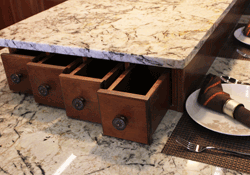Granite is an excellent choice for kitchen countertops, a frequently used work surface, because of its durability and longevity. Granite also contains unique physical characteristics in that this mineral is resistant to bacteria - inhibiting its ability to thrive and grow.
Granite is the hardest stone, after diamond, and this allows for a countertop that is not only impact and scratch resistant but it also is heat resistant. Granite countertops are an excellent choice when planning kitchen projects as they can add equity to your home.

Granite rock is the earths most abundant basement (below the surface) rock found around the world and it was formed from volcanic activity and immense underground pressure occurring millions of years ago. Granite blocks are quarried from the ground before being cut into slabs and polished. Granite is comprised of at least 20% quartz by volume and it also contains some feldspar and mica. Black granite contains very little quartz and feldspar and as such it has a slightly different composition.

Granite is ideal for countertops because it is heat and scratch resistant and it is available in almost any imaginable colour allowing you to match the countertop with your décor.
Cowry Cabinets features over 200 different styles of granite and quartz colours so we can help you find eye-catching styles of quartz or classic deep black granite to suit your taste.
Although there a number of specific granite cleaning products available in the marketplace, warm water with a mild or gentle soap works just as well with a non-scratching cloth like microfiber. Never use harsh cleaners like; vinegar, citric acids, bleach, ammonia or Windex. Using harsh cleaners will ultimately dull and weaken the granite sealant over a period of time. Wipe up any spills as soon as possible and your granite countertop will retain its shine and lustre.

Because granite is one of the world’s hardest stones it is virtually scratch resistant or at the very least because of its depth and colour it can hide small scratches very well. Granite will only be scratched by diamonds, specially sharpened tools or by another piece of granite. This is important to know because you DO NOT want to use granite cutting boards on granite countertops. Typical kitchen activity like hot pans and pots and cutting will not impact its surface – it is the perfect work surface and granite countertops can be thought of as one large cutting board.
Cowry Cabinets can help you design kitchen or bathroom plans for granite countertops to fit the room and space for your project. We work with granite specialists who have years of experience cutting and fitting granite stonework to the satisfaction of our customers.
Can Granite Be Damaged? – Like most hard surfaces it can be damaged with high-impact blows. Repair is sometimes possible using granite dust and an epoxy mixture.
Why Is Some Granite So Expensive? – Removing from the equation, high-profit margins some companies charge, granite’s prices vary depending on availability, quarry locations (higher shipping costs), rarity of colour and labour required to extract it – higher prices does not mean better quality.
Can Granite Crack? – Granite will not crack with normal day-to-day use.
Does Granite Stain? – All stone is somewhat porous. Granite is a very hard stone that is less porous compared to other types of stone although it is recommended to use a penetrating sealant to prevent liquids from soaking into its surface. As an example, some colours of granite may show a dark spot from water left to dry on the countertop. It is for this reason that liquids should be wiped up immediately on granite countertops.
Can Granite Burn? – Granite will not burn under ordinary use, in fact, you can set hot pans and pots directly from the stove onto the countertop.
Will There Be Seams On The Countertop? – There are limitations for the sizes of granite slabs and as such seams for countertops are necessary and sometimes unavoidable. Visibility of seams will depend on the colour, pattern and granularity of the slab of granite and just as important – the placement of the pieces being joined together.